When we think Cuenca, our imagination goes to the wonderful historic helmet which is surrounded by gorges of the Júcar and Huécar rivers and where the famous ones stand out Hanging houses.
In them is the Museum of Spanish Abstract Art, which has been defined as the “most beautiful small museum in the world.”
But in addition to this monumental complex completely surrounded by nature, in recent years the city of Cuenca It has another first-class attraction.
This is the Paleontological Museum of Castilla-La Mancha, inaugurated in 2015 and which shows the findings from different sites excavated in the Castilian-La Mancha community.
The most important of all these deposits are those of The Holes y the hollow, both in the Cuenca province, and which are considered among the most important in all of Europe.
All the information in detail
The best things to see in the Paleontological Museum of Castilla-La Mancha
Although these remains are of all types of species, both plants and animals, and of all sizes, what draws the most attention are those of Dinosaurs, of which there is a large quantity and variety.
Addition original remains found by researchers, the museum abounds with life size reproductions of some of those animals.
Of course, those of Dinosaurs They are the ones that attract attention and are the most photographed among visitors who have traveled to Basin.

Like any museum, it aims to inform visitors about known facts and raise questions about the topics covered.
In addition, the Paleontological Museum It is very entertaining for anyone, including the little ones in the family,
Dinosaurs in the Paleontological Museum in Cuenca
There we can see the dinosaur reproductions and other prehistoric animals that we find everywhere, in addition to videos and representations of life on Earth millions of years ago.
The museum is located in a modern, very original building, on an elevation known as Cerro Molina.
From some rooms and, above all, from the garden, you have a excellent panoramic view of the old city of Cuenca.

In this garden it has been installed, next to the life-size reproductions of various dinosaurs, a bank that is said to have one of the best views in the world and is the place where everyone wants to take a photo.
The visit, therefore, is divided into two spaces, the interior and the exterior.
Tour of life on Earth
If we we download the app from the museum, as we walk through its rooms we can obtain information about what we find.
The theme that runs through the whole set is Life on earth, from its beginnings to the world of hominids, a journey of almost 600 Ma.

What stands out the most is everything related to dinosaurs and their main deposits in the province of Cuenca.
Paleozoic fossils in the Paleontological Museum
One of the first things we learn in a paleontology museum is that “Ma” is short for “millions of years”, which is the most used measure of time in this science.
It must be insisted that these two deposits, The Hoyas and the Hollow, are among the most relevant in Europe of the mesozoic era.
The visit begins with a tour of the Paleozoic. At the beginning of this period, 542 Ma ago, all animals were marine but at the end, 252 Ma ago, terrestrial animals had already appeared.
ORGANIZE your TRIP
- Don't forget your TRAVEL INSURANCE with a 5% discount
- Book the HOTEL for your trip
- RENT a CAR for your trip
- The best TOURS and EXCURSIONS in Spanish
- NO-LINE TICKETS for museums and monuments
- Best FREE TOURS around the world
- Book your TRANSFER from the airport
- eSIM card with INTERNET at the best price
The group best known fossil animals of the Paleozoic They are trilobites, of which more than 20,000 species are known.
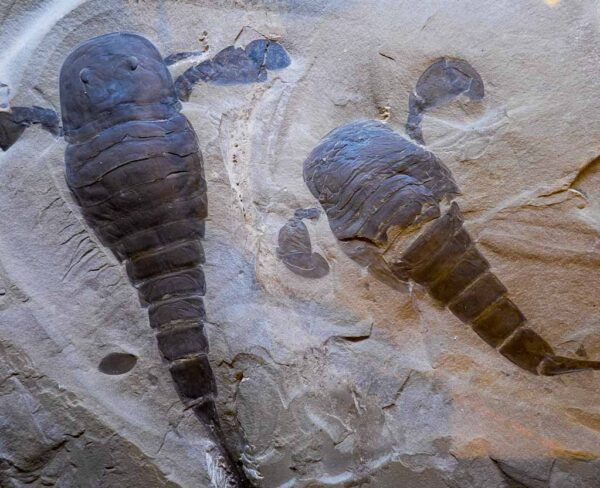
Among the plants, it is surprising to find the remains of the Omphalophloios Puertollanense, plants up to six meters that formed lush tropical forests in the area of current Puertollano.
Mesozoic Dinosaurs in the Paleontological Museum
Dinosaurs appear in the Triassic, the first phase of Mesozoic, when the emerged lands were united in the supercontinent Pangea, but they develop especially during the Jurassic.
Birds also appear, and in the Cretaceous appear the plants with flowers, Crocodiles and mammals, although in the end most of the dinosaurs become extinct.
The depth of time in these times is such that it is impressive to find coastal reptile remains of the Triassic, when 230 Ma ago they dominated the coast of Tethys sea in what is now the Castilian-Manchego territory.
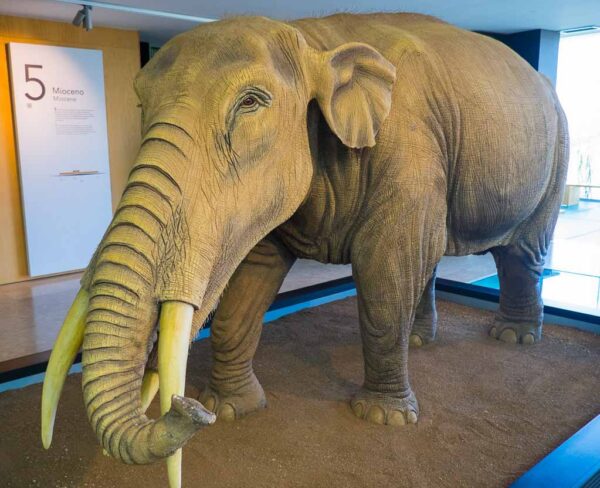
Or of the cephalopod mollusks of the Jurassic.
The same thing happens when we see bones and remains of dinosaur eggs.
After the dinosaur diversity crisis, in the Cenozoic another type of equally fascinating fauna develops.
These are the ancestors of the horses, Elephants o giraffes current, but also the precursors of hominids.
Some species of megafauna such as saber-toothed tiger, woolly rhino or cave bear They shared time with the first representatives of humanity.
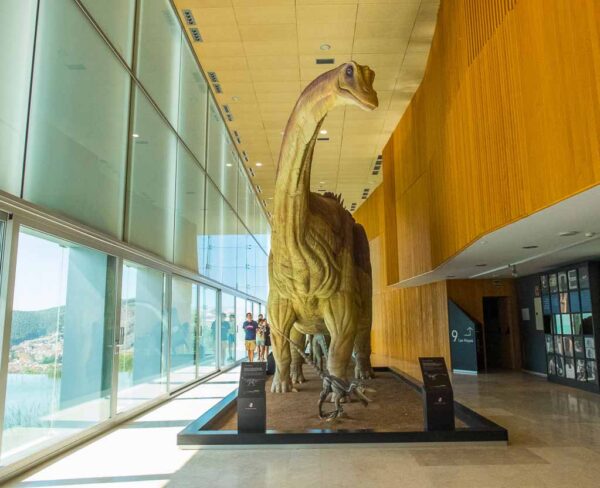
Dinosaurs in cinema and popular culture
Once finished the journey in time, the visit to the museum continues with various themes, of which the first, the one that fascinates everyone, is that of the dinosaurs.
The museum reviews the role they have played in popular culture, especially in cinema.
One of the curiosities is to remember that the film The Gwangi Valley, from 1969, was partly filmed in Cuenca, although the story takes place in Mexico.
In the film the Gwang dinosaurI live in a lost world, which is none other than the Enchanted City of Cuenca, from where it is taken to end up burning in none other than the cathedral.
Las Hoyas and Lo Hueco deposits in Cuenca
The last part of the tour is dedicated to the findings from Las Hoyas and Lo Hueco.
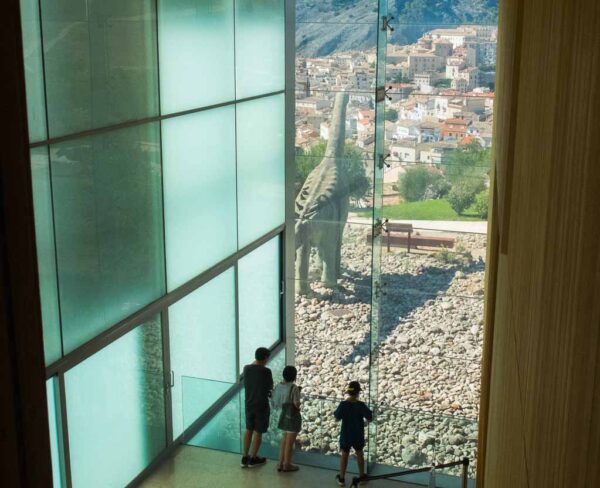
The great discoveries of Las Hoyas They date back to the 80s of the last century and stand out above all for their excellent state of conservation.
The fossils correspond mainly to animals and plants, but there are also remains of algae, fungi and bacteria, something exceptional since we are talking about remains from 125 Ma ago.
This is where the remains of the most complete dinosaur known in Spain.
It is a specimen of Concavenator corcovatus, the “humpbacked hunter of Cuenca”, who is popularly known as Pepito.
Don't forget your Travel Insurance
Are you organizing your trip or getaway? Don't leave without take out your travel insurance before, and here we explain why. If you hire it with us, you have a 5% discount
The discovery of the hollow It was carried out accidentally in 2007 during work to install the AVE tracks.
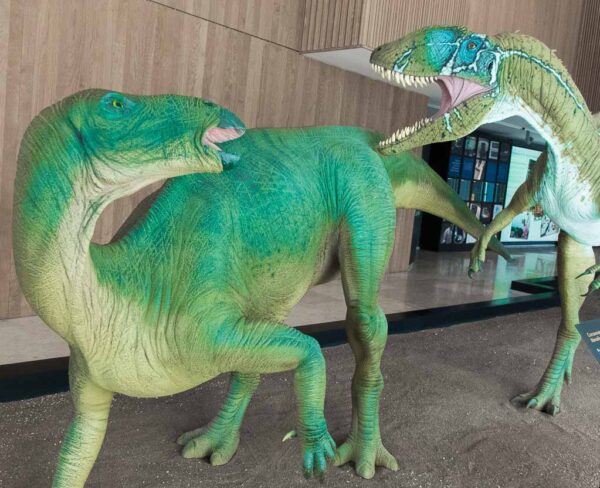
In one of the most important archaeological campaigns in history, 10.000 fossils were obtained, among which there are remains of fish, turtles, lizards, crocodiles and dinosaurs that inhabited this area 75 Ma ago.
The number of original pieces from these two sites is fascinating, even when they are small plant or animal remains.
Once the tour of the museum is over, you have to spend some time in the garden.
There appear the life-size reproductions of different dinosaurs who inhabited this region.
Among all of them we must highlight the aforementioned Concavenator, the famous Pepito.
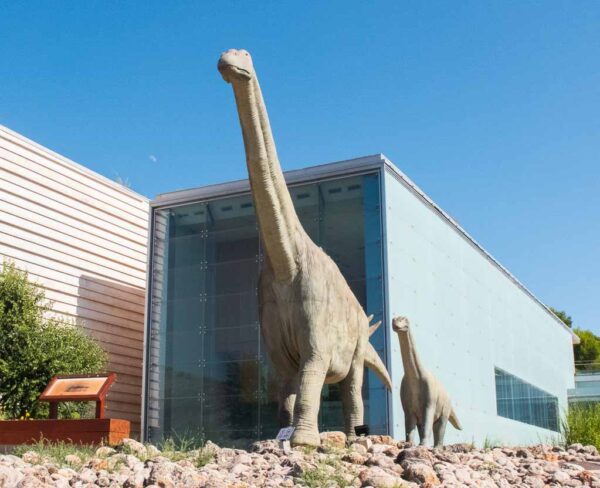
Some species of trees have also been planted, such as cedar and ginkgo biloba that in some way are similar to the vegetation that existed millions of years ago.
For much of the journey, the historic center of Cuenca has appeared in the landscape surrounding the museum, but the view from the garden is spectacular since it covers almost the entire monumental complex.
It is very curious to contemplate the urban profile of Cuenca behind the dinosaurs.
The visit normally ends at the bank from where you have the best view of the monumental area.

Cuenca Paleontological Museum Schedules
El Paleontological Museum of Cuenca Open every day of the week, except Mondays, with schedules from 10 to 14 and from 16 to 19.
On Sundays they are only open from 10 a.m. to 14 p.m.
Cuenca Paleontological Museum ticket prices
El Paleontological Museum ticket prices It is, generally, 5 euros.
La entrance to the gardens is free and independent of the museum, although it has the same opening hours.
Here you have updated information on the reduced prices and rates.
Book your hotel, 15% discount, free cancellation
When planning your trip, we advise you to, well in advance, Book your hotel now on booking.com where you can find discounts from 15% and you will have a possible cancellation for free
On weekends the Pepito Dinowalking, when a roaring, articulated copy of the museum's star dinosaur performs a performance with different actors.





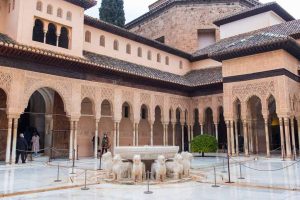











Comment